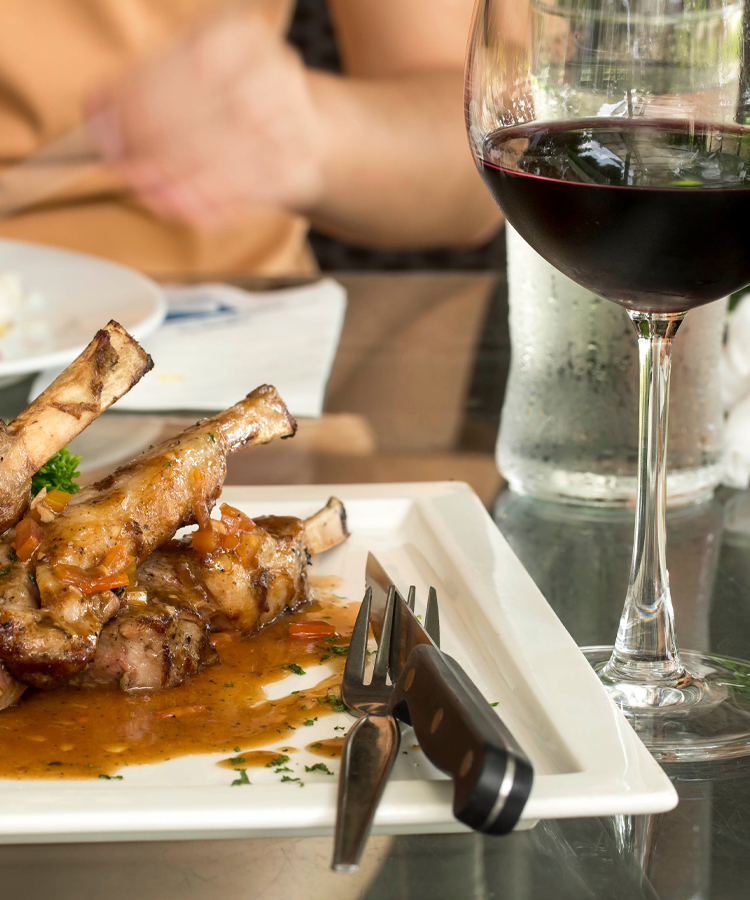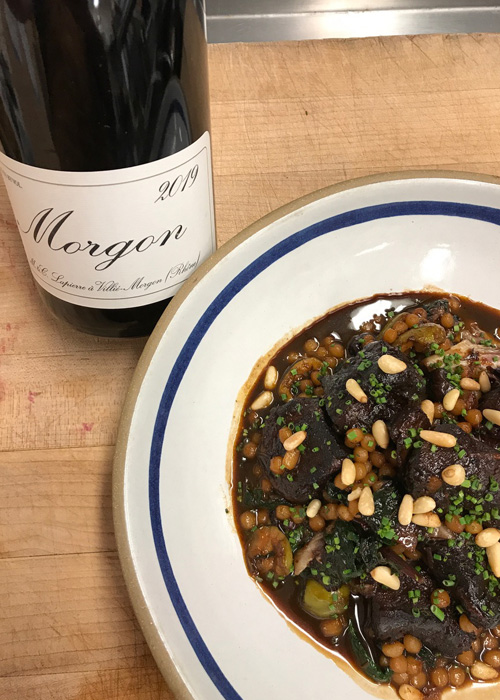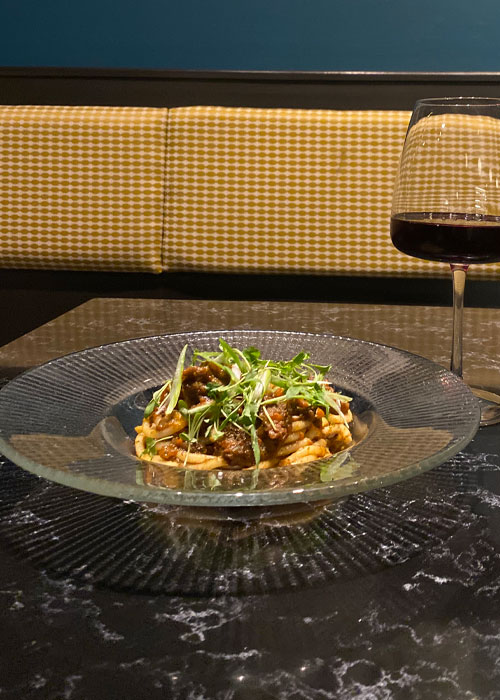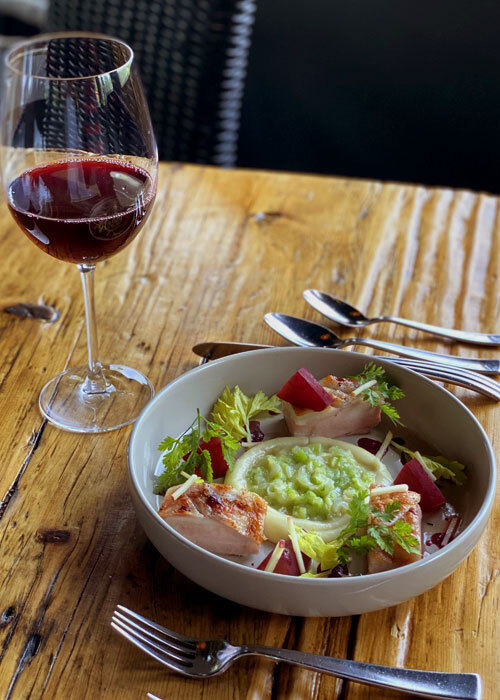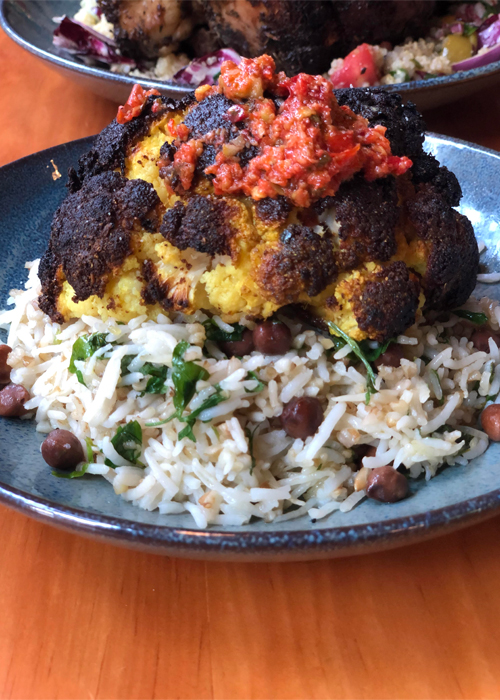
Wine and food pairing can be intimidating (you might end up with a “pros/cons” list, maybe ask your local sommelier for desperate help?). The truth is, some of the best moments with wine come when you simply have a dish you love, friends you love, and wine you love and it all comes together without fuss, creating an evening you’ll always look back on with a smile. This is the pinnacle of Beaujonomie, taking a moment to recognize how good it all can be. Of course, it helps to have a delicious wine on hand that’s as easygoing and precious as the moment itself. Enter: Beaujolais.
A region with 12 appellations, Beaujolais produces mostly Gamay-based reds, though with several notable Chardonnay-based whites and some piquant rosés as well. Whatever color you go with, the wines of the region are somehow both easygoing and complex, ancestral, and evolving, flexible to pair with an incredible variety of dishes, from robust cuts of meat to game birds to roasted vegetarian centerpieces worthy of a vegan holiday table. Like good company, Beaujolais creates a lively, resonant pairing with anything it encounters.
That’s thanks in large part to a region founded on tradition, where a new generation of winemakers commingle with their older-generation peers and together they move the dial forward. Much of that movement happens around the Gamay grape — its lively acidity, early ripening, and generous fruit — with special attention paid to the varying terroir of the larger Beaujolais AOC, which ranges from clay soils at lower altitudes to granite and limestone in higher volcanic soils.
In terms of understanding the region: Beaujolais has its over-arching AOC appellation as well as its smaller, slightly altitude-elevated Beaujolais-Villages designation, and then of course come the 10en distinct cru sub-regions (crus) of Beaujolais (which are also their own appellations), where winemaking practices range from ultra-old school and classically Burgundian (think: subtle notes of oak and thyme), to fresher fruit-driven styles characteristic of carbonic maceration, to natural winemaking that represents a responsible, trailblazing future for the region. Between the fruity, fresher AOC wines, the sophistication of Beaujolais-Villages, and the distinct approaches and terroirs of the Beaujolais crus, you get variation in the bottle that can accompany all manner of main courses.
To show the full potential of the wines from Beaujolais, we tapped four chefs from around the country to create dishes that will show how versatile the wines can be. The recipes range from a springy, toothsome oxtail pappardelle from Dayana Joseph of Apt4B in Atlanta to wild boar set deeply in autumnal flavors with apples and a creamy potato puree from Joe Schafer of Earth at Hidden Pond in Kennebunkport, Maine. Chef Laurence Edelman of Left Bank in New York opted to make a vegan spice-roasted cauliflower, while Alex Harrell of New Orleans’ Elysian Bar prepared a lamb tagine that combines tender, delicately gamey meat spiced in the classic Moroccan way.
Indeed, each chef found a pairing in Beaujolais that brings out the best in both the wine and food, highlighting the relationship at the core of Beaujonomie. “Most of the food I cook is meant to be shared,” says Harrell, who matches his lamb tagine with the concentrated fruit of Marcel Lapierre’s 2019 Morgon, perhaps one of the most famous of the Beaujolais crus. “Food is a vehicle that brings people together for community at a table.” Harrell’s pairing choice of a Marcel Lapierre helps foster that sense of Beaujonomie community at the table: it’s the product of a certified organic family vineyard in the Morgon cru that emphasizes the land, tradition, and the Beaujolais community at large.
The signature variety used in red Beaujolais is Gamay, known for its ready, juicy fruit flavors and vibrant acidity. If you can imagine the last time you had red meat with a fruity chutney or even brisket with a tart-sweet barbecue sauce, you’ll understand the easy relationship between Beaujolais and gamey, meaty, spicy flavors. Schafer takes full advantage of this kinship with his wild boar dish paired with Georges DuBoeuf’s “Jean Descombes” Morgon, which has flavors of dark plum skin, red currants, even a hint of spice — making it a heady match for rustic, autumnal flavors of boar and apple, the kind of flavors you’d expect to find hearthside with good company on a chilly night. “[Beaujonomie] brings everyone together over food and our food is plated for table sharing amongst friends and family,” says Schafer.
“Beaujolais inspires me because it has less tannin and is a lighter-bodied wine, which works to balance out some of my dishes that use a lot of deep, round spices such as clove and allspice,” says Dayana Joseph, who chose a round, fleshy wine from Christophe Pacalet in Chénas, the smallest of the Beaujolais crus, to pair with her rich, meaty oxtail pasta. The dish is topped with spring herbs that nicely bounce against the brightness of the Gamay fruit. In fact in this way, you can imagine the springiness of the dish responding to a younger Beaujolais AOC bottle, even the green of the herbs and the savory oxtail being deliciously cut through with a white Beaujolais made from Chardonnay. The region is a playground, in a way — and each dish has many potential playmates.
Take Chef Edelman’s vegan spice-roasted cauliflower, a dish that seems as exotic and pairing-tricky as they come. Nor does Chef Edelman shy away from showcasing his vegetable main: He bolsters the cauliflower’s lean meatiness with piquant green olive oil, tart racy red wine vinegar and Vadouvan (a French curry). That’s a lot of delicacy and exotic flavors at play, but they meet their match in the structured juiciness of a Beaujolais from the Morgon cru. And that’s a major aspect of what makes Beaujolais both fresh and fierce — structure but generous fruit and juiciness, able to play with spice or brood with rich dark meats. Here, between the savory roasted notes, complex curry blend, and the refined structure of the 2018 Jean Calot “Vielles Vignes” (old vines) pairing, you don’t notice any “lack” of meat — in fact you don’t notice any lack at all, and that’s the idea of Beaujonomie.
“Food and wine together set an ambiance for conversation, songs, and conviviality,” says Edelman. “Our best selves are realized when these connections with other people are made stronger. Good food and good wine set the table for a wonderful, well-lived life.”
Lamb Tagine
From: Alex Harrell of Elysian Bar, New Orleans
Pairing: 2019 Marcel Lapierre Morgon
Why it works: “I immediately thought that a braised lamb dish would be the perfect match for the 2019 Marcel Lapierre Morgon. I’m a sucker for a braise; it’s one of my favorite ways to cook and the wine itself is full-bodied with flavors of cherry and stone fruit and works really well with the lamb. I included dried cherries in the recipe to add some flavors of dark fruit to match those of the wine.”
Oxtail Pappardelle Pasta with Spring Herbs
From: Dayana Joseph, Apt4B, Atlanta
Pairing: 2017 Christophe Pacalet Chénas
Why it works: “This dish is inspired by my Haitian roots and my love for Italian food and pasta,” says Chef Joseph. “I wanted to blend both elements to create something that would pair well with a deep Beaujolais.”
Wild Boar, Apples, Leek Étuvée, Pomme Purée, Morgon Beurre Rouge, Chervil, Apple and Celery Hearts Salad
From: Joe Schafer of Earth at Hidden Pond, Kennebunkport, Maine
Pairing: Georges Duboeuf “Jean Descombes” Morgon
Why it works: “I usually pair wines with the dishes I create by weight. Heavier food (red meats, braised lamb chops) requires a heavier wine; lighter food (crudo, crisp raw fish salads, citrusy food) [require] lighter wines. Beaujolais is a light-to-medium red that pairs well with all kinds of food.”
Spice-Roasted Cauliflower
From: Laurence Edelman, Left Bank, New York
Pairing: 2018 Domaine Jean Calot “Vielles Vignes” Morgon
Why it works: “I often try to serve wine that will balance the flavors of a dish. Sometimes it’s good to lay it on thick and repeat those same flavors. Wine and food have an intimate relationship and there are a lot of ways to get it right. Beaujolais is no exception.”
This article is sponsored by Beaujolais.
